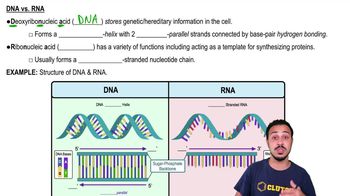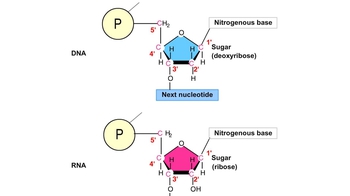Table of contents
- 1. Introduction to Biology2h 42m
- 2. Chemistry3h 40m
- 3. Water1h 26m
- 4. Biomolecules2h 23m
- 5. Cell Components2h 26m
- 6. The Membrane2h 31m
- 7. Energy and Metabolism2h 0m
- 8. Respiration2h 40m
- 9. Photosynthesis2h 49m
- 10. Cell Signaling59m
- 11. Cell Division2h 47m
- 12. Meiosis2h 0m
- 13. Mendelian Genetics4h 44m
- Introduction to Mendel's Experiments7m
- Genotype vs. Phenotype17m
- Punnett Squares13m
- Mendel's Experiments26m
- Mendel's Laws18m
- Monohybrid Crosses19m
- Test Crosses14m
- Dihybrid Crosses20m
- Punnett Square Probability26m
- Incomplete Dominance vs. Codominance20m
- Epistasis7m
- Non-Mendelian Genetics12m
- Pedigrees6m
- Autosomal Inheritance21m
- Sex-Linked Inheritance43m
- X-Inactivation9m
- 14. DNA Synthesis2h 27m
- 15. Gene Expression3h 20m
- 16. Regulation of Expression3h 31m
- Introduction to Regulation of Gene Expression13m
- Prokaryotic Gene Regulation via Operons27m
- The Lac Operon21m
- Glucose's Impact on Lac Operon25m
- The Trp Operon20m
- Review of the Lac Operon & Trp Operon11m
- Introduction to Eukaryotic Gene Regulation9m
- Eukaryotic Chromatin Modifications16m
- Eukaryotic Transcriptional Control22m
- Eukaryotic Post-Transcriptional Regulation28m
- Eukaryotic Post-Translational Regulation13m
- 17. Viruses37m
- 18. Biotechnology2h 58m
- 19. Genomics17m
- 20. Development1h 5m
- 21. Evolution3h 1m
- 22. Evolution of Populations3h 52m
- 23. Speciation1h 37m
- 24. History of Life on Earth2h 6m
- 25. Phylogeny2h 31m
- 26. Prokaryotes4h 59m
- 27. Protists1h 12m
- 28. Plants1h 22m
- 29. Fungi36m
- 30. Overview of Animals34m
- 31. Invertebrates1h 2m
- 32. Vertebrates50m
- 33. Plant Anatomy1h 3m
- 34. Vascular Plant Transport1h 2m
- 35. Soil37m
- 36. Plant Reproduction47m
- 37. Plant Sensation and Response1h 9m
- 38. Animal Form and Function1h 19m
- 39. Digestive System1h 10m
- 40. Circulatory System1h 57m
- 41. Immune System1h 12m
- 42. Osmoregulation and Excretion50m
- 43. Endocrine System1h 4m
- 44. Animal Reproduction1h 2m
- 45. Nervous System1h 55m
- 46. Sensory Systems46m
- 47. Muscle Systems23m
- 48. Ecology3h 11m
- Introduction to Ecology20m
- Biogeography14m
- Earth's Climate Patterns50m
- Introduction to Terrestrial Biomes10m
- Terrestrial Biomes: Near Equator13m
- Terrestrial Biomes: Temperate Regions10m
- Terrestrial Biomes: Northern Regions15m
- Introduction to Aquatic Biomes27m
- Freshwater Aquatic Biomes14m
- Marine Aquatic Biomes13m
- 49. Animal Behavior28m
- 50. Population Ecology3h 41m
- Introduction to Population Ecology28m
- Population Sampling Methods23m
- Life History12m
- Population Demography17m
- Factors Limiting Population Growth14m
- Introduction to Population Growth Models22m
- Linear Population Growth6m
- Exponential Population Growth29m
- Logistic Population Growth32m
- r/K Selection10m
- The Human Population22m
- 51. Community Ecology2h 46m
- Introduction to Community Ecology2m
- Introduction to Community Interactions9m
- Community Interactions: Competition (-/-)38m
- Community Interactions: Exploitation (+/-)23m
- Community Interactions: Mutualism (+/+) & Commensalism (+/0)9m
- Community Structure35m
- Community Dynamics26m
- Geographic Impact on Communities21m
- 52. Ecosystems2h 36m
- 53. Conservation Biology24m
4. Biomolecules
Nucleic Acids
Problem 6`
Textbook Question
If nucleotides from the DNA of a human were quantified and 30 percent of them contained the base adenine, what percentage of them would contain the base guanine?
a. 20 percent
b. 30 percent
c. 40 percent
d. 70 percent
 Verified step by step guidance
Verified step by step guidance1
Understand the base pairing rules in DNA: Adenine (A) pairs with Thymine (T), and Cytosine (C) pairs with Guanine (G). This means the percentage of adenine will equal the percentage of thymine, and the percentage of cytosine will equal the percentage of guanine.
Given that 30% of the nucleotides contain adenine, it follows that 30% must also contain thymine due to the base pairing rule.
Calculate the combined percentage of adenine and thymine: Since adenine and thymine each make up 30% of the nucleotides, together they account for 60% of the DNA.
Determine the remaining percentage for cytosine and guanine: Since adenine and thymine together make up 60%, the remaining 40% of the nucleotides must be cytosine and guanine.
Divide the remaining percentage equally between cytosine and guanine: Since cytosine and guanine pair together, they must each make up half of the remaining 40%, resulting in 20% for guanine.
 Verified video answer for a similar problem:
Verified video answer for a similar problem:This video solution was recommended by our tutors as helpful for the problem above
Video duration:
3mPlay a video:
Was this helpful?
Key Concepts
Here are the essential concepts you must grasp in order to answer the question correctly.
Base Pairing Rules
In DNA, base pairing rules dictate that adenine (A) pairs with thymine (T), and guanine (G) pairs with cytosine (C). This means that the amount of adenine is equal to thymine, and the amount of guanine is equal to cytosine. Understanding these rules is crucial for determining the composition of DNA strands.
Recommended video:
Guided course

Chargaff's Rules
Chargaff's Rules
Chargaff's rules state that in any given DNA molecule, the amount of adenine equals thymine, and the amount of guanine equals cytosine. This implies that the total percentage of purines (adenine and guanine) equals the total percentage of pyrimidines (thymine and cytosine), which is essential for calculating nucleotide percentages.
Recommended video:
Guided course

Chargaff's Rules
Percentage Calculation in DNA
To calculate the percentage of a specific base in DNA, use the known percentage of its complementary base. If adenine is 30%, then thymine is also 30%. The remaining 40% of the DNA is split equally between guanine and cytosine, making each 20%. This calculation is based on the total percentage of all bases summing to 100%.
Recommended video:
Guided course

DNA Polymerases
Related Videos
Related Practice



















